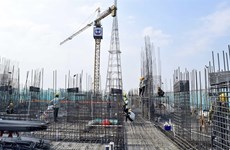Encouraging private participation to help airport development take off
 Van Don International Airport is the first private airport in Vietnam. (Photo: Vietnam+)
Van Don International Airport is the first private airport in Vietnam. (Photo: Vietnam+)Hanoi (VNA)- In the context that many localities have applied for the funding to build new airports, representatives of state management agencies said, the airport planning should be open, and it needs a careful calculation to yield an effective exploitation model.
In addition, to mobilize investment capital, the State should also open the door to the private sector and encourage investment in the form of public-private partnership (PPP) to reduce the budget burden for the State.
According to Associate Professor-Dr. Nguyen Duy Dong, Vice Chairman of the Vietnam Association on Aviation Science and Technology, when a region wants to invest in an airport, it is necessary to build basic and reasonable criteria. Besides, it must consider the socio-economic efficiency of an airport, based on the three aspects of politics, national security and economic development.
Airport systems in other countries are divided into many categories such as aerial ports, regular airports, service airports, and dual-use airports. Localities must carefully study the feasibility of projects, such as the location of the airport for convenient take-off and landing. They must also set up an airport construction project in accordance with the provisions of the law as well as ensure technical issues.
For airport development projects, localities need to offer many possible options, Dong said, adding that their financial capacity must also be ensured. Mr. Dong went on to say that, a new airport construction project needs capital up to trillions of VND and needs to consider market demand. This is the most important factor because the new airport can only operate effectively when it is able to attract customers and sell tickets.
As for the airport network planning and the fact that too many provinces proposed to build new airports, Mr. Dong said, their proposals should be included in the comprehensive planning of both large and small airports.
Sharing this view, Mr. Phan Duc Hieu, Standing member of the National Assembly Economic Committee, said that localities need to carefully calculate airport development to have a clearer and more detailed exploitation model.
Under a recent draft airport plan, there will be 28 airports by 2030 and 31 by 2050.
Regarding the matter, Mr. Nguyen Van Vinh, Deputy Director of the Institute of Development Strategy at the Ministry of Planning and Investment asked, “If the localities make appropriate proposals for the increase of airports to 40, then could they lose the opportunity after undertaking all of the planning?”
To be able to implement the airport planning for the period 2021-2030 and a vision to 2050, the Ministry of Transport has calculated and mobilized various investment resources. These include ODA loans, budget capital, commercial loans from financial institutions, and socialized capital in the form of PPP.
According to Mr. Vinh, privatizing a large airport in Vietnam is not simple. To attract private capital, the State management agency and the investor need to pay attention to synchronizing other transport infrastructure systems connecting to the airport.
 With the participation of private capital, the infrastructure of the aviation industry will be increasingly developed. (Photo: Vietnam+)
With the participation of private capital, the infrastructure of the aviation industry will be increasingly developed. (Photo: Vietnam+)Mr. Tran Dinh Thien, former Director of the Vietnam Institute of Economics, said that through the example of Van Don airport in Quang Ninh province, private participation is required to solve the country's major transport and air infrastructure needs.
Affirming that investment capital in airport construction is very important, Mr. Kenneth Atkinson, President of the British Business Association in Vietnam, said that the PPP model has been applied at a number of airports such as Cam Ranh and Phnom Penh, Siem Reap (Cambodia). This model reduces the burden of State and local budgets, and instead places it on the shoulders of private investors./.












